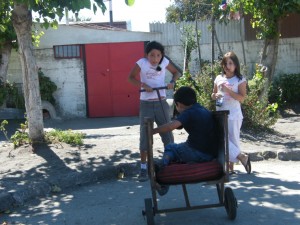 Karen Anderson, missionary of the ELCA assigned to EPES writes:While nervous parents lined up to get water from the EPES well, accompanied bychildren too frightened to stay behind at home, the EPES staff produced crayons and paper from office supplies recovered from the disarray, and encouraged thechildren to draw.
Karen Anderson, missionary of the ELCA assigned to EPES writes:While nervous parents lined up to get water from the EPES well, accompanied bychildren too frightened to stay behind at home, the EPES staff produced crayons and paper from office supplies recovered from the disarray, and encouraged thechildren to draw. “All the drawings and all the talk is about the earthquake,” reports Maria Stella Toro Santiago-based EPES educatorwho traveled to Concepción last week to support the local staff. “The level oftrauma is high.”
In the street, children are taking turns tossing one another about in an old handcart in their newly invented game of “Earthquake and Aftershocks.
— “How strong was that?” someone asks.
— “That was a 9!” the young girl vigorouslyshaking the cart announces, as a little boy relinquishes his space in the hotseat to the next comer.
As the shaking gets more energetic (“That’s an11!” an onlooker announces), the little girl’s bravado crumbles. “That’senough, Karina,” she pleads, “not so strong.”
Bravado,acting out and game-playing are all coping mechanisms that children adopt inthe aftermath of traumatic experiences like Chile’s 8.8 quake, one of thestrongest ever recorded in a country whose deceptively modern facade iscrumbling along social fault lines exposed by the seismic cataclysm.”
The reality is that the trauma caused by the earthquakes and after shocks both in Chile as well as in Haiti, needs to be adressed. EPES has been working with an organization that is providing them with the tools and skills to work on trauma healing with children. The Lutheran Church in Haiti has in its agenda to do some treauma healing with the communities where they work. Trauma healing is the least that comes up in our minds when we think about disaster reflief but it is a fundamental issue to address. The scars are long lasting.
